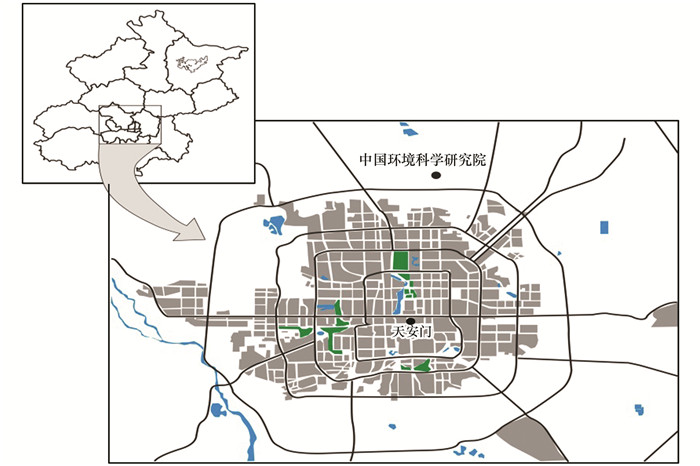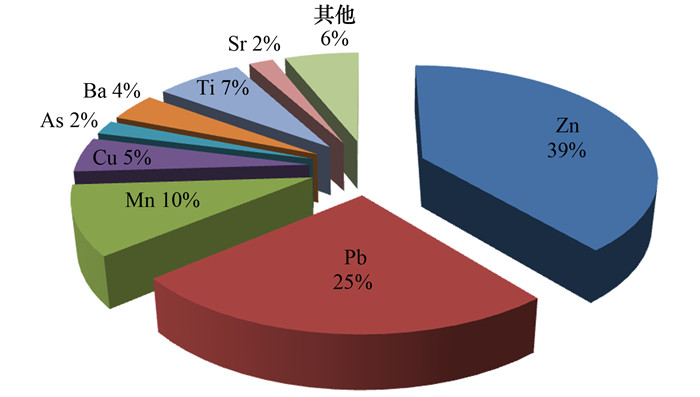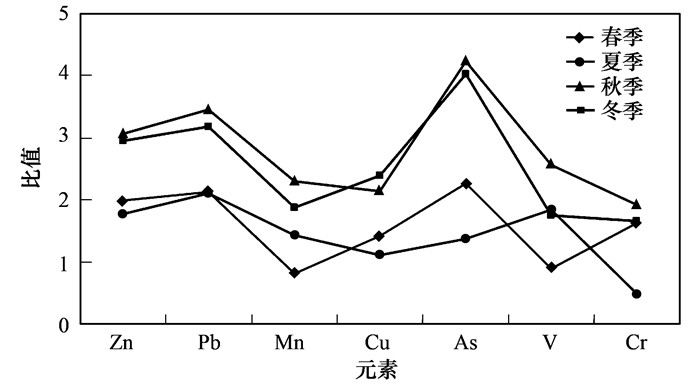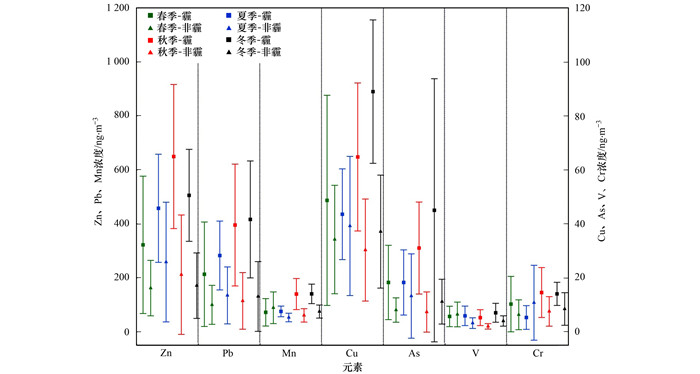2. 中国环境科学研究院, 环境基准与风险评估国家重点实验室, 北京 100012;
3. 兰州大学资源环境学院西部环境教育部重点实验室, 兰州 730000;
4. 清华大学环境学院, 环境模拟与污染控制国家重点联合实验室, 北京 100084;
5. 中国科学院生态环境研究中心, 北京 100085
2. State Key Laboratory of Environmental Criteria and Risk Assessment, Chinese Research Academy of Environmental Sciences, Beijing 100012, China;
3. Key Laboratory of Western China's Environmental Systems(Ministry of Education), Lanzhou University, Lanzhou 730000, China;
4. State Key Joint Laboratory of Environment Simulation and Pollution Control, School of Environment, Tsinghua University, Beijing 100084, China;
5. Research Center for Eco-Environmental Sciences, Chinese Academy of Sciences, Beijing 100085, China
大气颗粒物中的重金属不可降解, 且具有毒性和生物有效性[1, 2].它的长期存在可能对环境构成极大的潜在威胁[3], 对其暴露可侵害呼吸系统, 诱发心脏病、肺病、降低肺功能, 甚至引发癌症[4, 5].其中As和Cd对人体有潜在致畸作用, 而Pb和Hg对胎儿有毒性作用[4].环境中的As、Cd、Cr、Hg、Mn、Ni、Pb和V会导致鼻窦炎、哮喘、慢性支气管炎、肺炎、肺出血、肺癌和脑出血等多种疾病[5].研究表明, 大气中约70%~80%的金属元素吸附于细颗粒物中, 且粒径越小含量越高[6~8].北京PM2.5污染严重[9], 其环境健康效应已引起国内外学者的普遍关注.国内外学者对PM2. 5中重金属的污染特征、来源和健康影响做了大量工作.有研究发现PM2.5中重金属主要来源于煤燃烧、土壤尘、汽车尾气、冶金及机械制造业、海盐和区域性污染源的输送等[10~15].胡子梅等[16]发现上海PM2.5中Cr的风险指数偏高, 对人体的健康的潜在危险较大.李丽娟等[17]发现PM2.5重金属存在非致癌风险且儿童非致癌风险明显高于成人. Pongpiachan等[18]研究也发现PM2.5重金属元素都具有一定的潜在健康危险, 因此实施有效的长期计划来降低PM2.5中重金属浓度至关重要.本研究开展了针对北京大气重金属一年的数据分析与讨论, 其结论对于政府制定政策以降低重金属污染及危害具有一定的参考价值.
1 材料与方法 1.1 样品采集利用Thermo TE-6070大流量(1.13 m3·min-1)PM2.5采样器, 于2011-07-06~2012-06-27期间每3 d采集一次24 h PM2.5样品, 以获得全面、有代表性的PM2.5样品进行研究, 共采集有效样品109个.根据采样时间分为4个季节5个时间段:2011年夏季(2011-07-06~2011-08-29, 共采集样品19个)、2011年秋季(2011-09-01~2011-11-30, 共采集样品27个)、2011年冬季(2011-12-03~2012-02-28, 共采集样品25个)、2012年春季(2012-03-02~2012-05-31, 共采集样品25个)、2012年夏季(2012-06-03~2012-06-27, 共采集样品8个).采样点位于北京市朝阳区中国环境科学研究院大气楼楼顶(40.05 °N, 116.42 °E), 距地面约15 m, 附近没有明显的工业区及局地污染源.根据近年来的研究结果[19], 北京市受区域性污染影响较为严重, 在北京市区范围内大气颗粒物的成分特征较为一致, 单一采样点仍能较好代表北京市污染状况, 因此本研究为获得更好的时间变化趋势和统计代表性, 采取了单点长期的采样方案, 具体采样点如图 1所示.采样前对仪器流量进行校正, 并对PM2.5切割头进行清洗.采样滤膜为石英滤膜, 采样前用铝箔纸包裹放置在马弗炉中, 于480℃高温下灼烧4 h以除去滤膜上残留的挥发性有机物, 采样前后滤膜均采取避光密封低温保存.

|
图 1 采样点位示意 Fig. 1 Map of the sampling sites |
PM2.5样品中重金属的分析工作在清华大学环境学院中意环境节能楼公共实验平台进行.采用Thermo Fisher X Series 2电感耦合等离子体质谱(ICP-MS)进行分析, 共分析元素20种, 分别为Li、V、Cr、Mn、Co、Cu、Zn、As、Se、Ti、Ga、Ni、Sr、Cd、In、Ba、Tl、Pb、Bi和U.用土壤标准物质GSS-5做各种金属元素回收率的实验, 回收率在90%~110%之间.水溶性离子(Water-Soluble Ions, WSI)样品用KQ-500DB型数控超声波清洗器促进样品溶解, 用0.45 μm滤头过滤得水溶液后使用ICS-2100离子色谱仪进行样品分析.
1.3 气象数据观测期间的气象数据采用“wunderground”(http://www.wunderground.com/)北京市后海气象站(40.1°N, 116.6°E)每隔30 min的地面气象观测数据(相对湿度和能见度).
2 结果与讨论 2.1 大气颗粒物中重金属的浓度水平如图 2所示, 分析的20种元素中Zn、Pb、Mn、Cu、As、Ba、Ti和Sr是所测金属元素中丰度较高的几种元素, 其含量占重金属总量的94%.综合考虑重金属对健康的影响和国内外研究的成熟度, 本研究重点选取Zn、Pb、Mn、Cu、As、V和Cr这7种主要重金属元素进行重点讨论.

|
图 2 采样期间颗粒物中重金属各组分比例 Fig. 2 Proportion of heavy metals in fine particles during sampling |
如表 1, 2011~2012年, 北京市PM2.5中重金属Zn、Pb、Mn、Cu、As、V和Cr的平均质量浓度分别为(331.30±254.52)、(212.64±182.06)、(85.96±47.00)、(45.19±27.74)、(17.13±19.02)、(4.92±3.38) 和(9.04±7.84) ng·m-3.根据我国现行环境空气质量标准[20]和WHO环境空气质量标准[21], 其中Pb、Mn和V未超过浓度参考限值的500、150和1 000 ng·m-3, 但As分别超出我国现行环境空气质量标准和WHO环境空气质量标准浓度参考限值6 ng·m-3和6.6 ng·m-3的2.86倍和2.60倍.如表 2, 与国内其他地区研究数据相比, 北京地区重金属Zn、Pb、Mn和Cu的污染较重, 污染水平在国内处于较高地位; 北京地区重金属As、V和Cr的污染相比国内其他地区略低, 但As的污染超标严重任应引起关注.与国外地区研究数据相比, 北京重金属Zn、Pb、Mn、Cu、As、V和Cr污染严重, 污染水平较高.
|
|
表 1 不同季节PM2.5中重金属日均浓度值/ng·m-3 Table 1 Concentration of heavy metals in PM2.5 in different seasons/ng·m-3 |
|
|
表 2 世界不同城市大气颗粒物中重金属元素质量浓度特征/ng·m-3 Table 2 Heavy metal concentrations in aerosols in different world cities/ng·m-3 |
2.2 大气颗粒物中主要重金属季节变化特征
表 1为采样期间不同季节PM2.5中几种主要重金属的日均浓度值, 其中夏季数据为2011年夏季和2012夏季数据的综合.秋季重金属Zn的日均浓度最高为(422.44±326.94) ng·m-3.秋季Zn浓度处在较高的污染水平, 浓度变化范围较大.
PM2.5中重金属Pb在秋季日均浓度最高为(249.95±222.52) ng·m-3, 其中秋季Pb浓度变化最大(26.50~908.92 ng·m-3).尽管各季节Pb的日均值都低于我国环境空气质量新标准中和WHO中年平均500 ng·m-3的浓度限值, 但是夏季、秋季、冬季和春季都有个别采样日期超出WHO的浓度限值, 超标天数分别为1、3、3和1d.
重金属Mn秋季日均浓度最高(99.10±58.85) ng·m-3, 不同季节Mn的日均浓度相差不大.采样期间北京PM2.5中Mn的浓度共有12 d的浓度值超出WHO的限值, 各季节所占天数分别为:秋季6 d、冬季3 d和春季3 d.重金属V的季节变化特征与Mn一致, 秋季浓度变化幅度最大, 冬季最小.说明重金属Mn和V可能有相似来源.
As受自然源和人为源共同影响[31], 但其主要来自金属冶炼、汽车排放和矿物质燃烧等人为源[32, 33], 土壤中的As可进入大气加重污染[34].北京PM2.5中As污染严重, 冬季日均浓度最高(20.65±19.71) ng·m-3.各季节PM2.5中As的日均浓度均远高于WHO中As的浓度限值(6.6 ng·m-3)和我国空气质量标准As浓度限值(6 ng·m-3).
重金属Cu季节变化特征与As一致, 只是不同季节Cu的日均质量浓度相差较小, 冬季日均质量浓度最高, 为(51.68±32.41) ng·m-3.
Cr不同季节日均浓度大小为秋季>冬季>春季>夏季.春季浓度变化范围最大, 秋季最小.环境样品中无机铬主要以Cr3+和Cr6+两种形态存在.其中Cr6+有强致癌作用.我国空气质量新标准和WHO均只规定了Cr6+的浓度限值, 而文中则以总Cr浓度为主.由于国内外数据有限, 不能从总Cr浓度中准确确定Cr6+的浓度.但总Cr的浓度远超过标准中Cr6+0.025 ng·m-3的限值, 应当引起重视.
整体看来, 采样期间秋冬季节PM2.5中重金属污染较春夏季严重, 这可能与北京秋冬季节取暖导致煤燃烧增加有关.
2.3 霾与非霾天大气颗粒物中重金属浓度霾定义为相对湿度 < 90%时大气混浊视野模糊导致的能见度恶化(能见度 < 10 km)的天气现象[35], 则采样期间夏季霾天与非霾天分别为19 d和8 d; 秋季霾天13 d、非霾天14 d; 冬季霾天7 d、非霾天18 d; 春季霾天10 d、非霾天15 d.
由图 3不同季节霾天北京PM2.5中主要重金属浓度增量可知, 霾过程会加剧北京PM2.5中主要重金属的污染, 霾天Zn、Pb、Mn、Cu、As、V和Cr的浓度分别是非霾天的1.77~3.07倍、2.10~3.46倍、0.81~2.30倍、1.11~2.39倍、1.38~4.23倍、0.89~2.57倍和0.49~1.93倍.霾天对重金属污染的增加作用呈现一定的季节变化特征.霾过程对Zn、Pb、Cu、As和Cr的增加作用表现为秋季>冬季>春季>夏季, 对重金属Mn的作用则表现为秋季>冬季>夏季>春季, 对重金属V的作用则表现为秋季>夏季>冬季>春季.

|
图 3 不同季节霾天重金属浓度与非霾天浓度比值 Fig. 3 Ratios of heavy metals in haze to non-haze days during different seasons |
图 4为采样期间霾与非霾天重金属浓度日均值.霾期间春季重金属Zn、Pb和Mn的日均浓度最低, 分别为322.48、213.22和72.52 ng·m-3; 夏季重金属Cu、As和Cr日均浓度最低, 分别为43.58、18.27和5.31 ng·m-3; 秋季重金属V的日均浓度最低, 为5.25ng·m-3; 秋季重金属Zn和Cr日均浓度最高, 分别为649.36 ng·m-3和14.59ng·m-3; 冬季Pb、Mn、Cu、As和V日均浓度最高, 分别为416.59、140.49、88.99、45.04和7.07 ng·m-3.除春季重金属Mn和V和夏季Cr日均浓度比非霾期间略有减少外, 其他主要重金属霾天的日均浓度较非霾天均有显著增加, 其中秋季重金属Zn、Mn、V和Cr日均浓度增量最高, 增量分别为437.63、79.15、3.21和7.02 ng·m-3; 冬季重金属Pb、Cu和As日均浓度增量最高, 增量分别为285.53、51.83和33.86 ng·m-3.春季重金属Zn和Pb日均浓度的增量最低, 增量分别为160.15 ng·m-3和113.04 ng·m-3; 夏季重金属Cu和As日均浓度的增量最低, 增量分别为4.36ng·m-3和5.01 ng·m-3.春季霾天重金属Mn、V和夏季Cr的浓度略有降低, 这可能是由于霾过程是颗粒物粒径逐渐增大的过程, 春季霾天重金属Mn、V和夏季Cr可能由细颗粒物向粗颗粒物中转移, 因而导致PM2.5中浓度降低.秋冬季节霾期间颗粒物中主要重金属元素的浓度均显著增高, 这主要可能是受秋季生物质燃烧、农业活动增加和冬季采暖煤燃烧量增大的影响.

|
图 4 不同季节霾与非霾北京PM2.5中重金属质量浓度 Fig. 4 Heavy metals concentrations in haze and non-haze during different seasons |
将采样期间北京PM2.5中重金属及水溶性离子用SPSS进行主成分提取, 并将初始成分负载矩阵进行方差最大正交旋转, 旋转后的负载矩阵如表 3所示.分析中提取的4种主要成分的累计因子方差贡献率达到81.32%, 结果较为理想, 可以反映主要的污染源类型.
|
|
表 3 北京PM2.5中重金属主成分分析矩阵 Table 3 Principal component analysis of heavy metals in PM2.5 |
因子1中载荷较高的重金属为Li、Mn、Co、Ba、Sr、Mg2+和Ca2+, 该因子的方差贡献率为46.98%. Mg2+、Ca2+和Ba主要来自地壳源[36, 37], Co是冶金化工尘的标志性元素[38], 大气中Li的主要来源有陶瓷业、制铝工业、建筑扬尘和道路扬尘等.北京市区无冶金、陶瓷和制铝工业污染源, 因此因子1可能主要代表扬尘(包括建筑扬尘和道路扬尘), 北京拥有550万辆机动车, 机动车可能对道路扬尘有比较大的影响.因子2中载荷较高的为Zn、Pb、Se、Cd、As、Bi和K+, 该因子的贡献率为23.52%.Zn、Pb、As和Se主要来源于煤燃烧的排放, 同时Pb是机动车排放和冶金化工尘的特征元素.由于近十几年来使用无铅汽油, 汽车尾气不是大气Pb的重要来源; Cd主要来源于工业过程产生的废气, 如冶炼、燃煤、垃圾焚烧等, 生物质和煤燃烧是K+的最主要来源[39~41]; 北京市区工业污染源较少, 因此因子2为煤燃烧源.虽然该因子累计因子方差贡献率不是很高, 但对危害较大重金属元素有较大贡献, 可能与北京秋冬季有长时间的燃煤取暖有关.因子3中载荷较高的为V、Zn、Se、K+、SO42-、NO3-和NH4+, 该因子贡献率为6.08%, V是化石燃料燃烧的标志性元素, Zn和Se主要来自煤燃烧, K+是生物质燃烧的标志性元素, 同时机动车、煤燃烧等过程排放的NOx或SO2等污染气体二次转化会形成大量二次无机气溶胶.有研究表明, 外地排放的一次污染物以及在传输过程中形成的二次污染物对北京有重要影响[12], 因此因子3代表远距离输送源.因子4中载荷较高的为Cu、Zn、As、Cd、Tl、Na+和Cl-, 贡献率为4.74%, 北京城区受海盐颗粒影响较小, 因子4可能是其他工业来源.
通过因子分析可知, 北京大气颗粒物中重金属主要来源于扬尘(包括建筑扬尘和道路扬尘)和煤燃烧, 少量来自远距离输送和其他工业来源.
3 结论(1) 北京市PM2.5中重金属Zn、Pb、Mn、Cu、As、V和Cr的平均质量浓度分别为(331.30±254.52)、(212.64±182.06)、(85.96±47.00)、(45.19±27.74)、(17.13±19.02)、(4.92±3.38) 和(9.04±7.84) ng·m-3.
(2) 采样期间秋冬季节PM2.5中重金属污染较春夏季节严重, 这可能与北京秋冬季节取暖导致煤燃烧增加有关.
(3) 霾过程会加剧北京PM2.5中主要重金属Zn、Pb、Mn、Cu、As、V和Cr的污染, 霾天对重金属污染的增加作用呈现一定的季节变化特征.
(4) 通过因子分析可知, 北京大气颗粒物中重金属主要来源于扬尘(包括建筑扬尘和道路扬尘)和煤燃烧, 少量来自远距离输送和其他工业来源.
| [1] | Limbeck A, Wagner C, Lendl B, et al. Determination of water soluble trace metals in airborne particulate matter using a dynamic extraction procedure with on-line inductively coupled plasma optical emission spectrometric detection[J]. Analytica Chimica Acta, 2012, 750: 111-119. DOI:10.1016/j.aca.2012.05.005 |
| [2] | Sato K, Tamura T, Furuta N. Partitioning between soluble and insoluble fractions of major and trace elements in size-classified airborne particulate matter collected in Tokyo[J]. Journal of Environmental Monitoring, 2008, 10(2): 211-218. DOI:10.1039/B709937A |
| [3] |
谢华林, 张萍, 贺惠, 等. 大气颗粒物中重金属元素在不同粒径上的形态分布[J]. 环境工程, 2002, 20(6): 55-57. Xie H L, Zhang P, He H, et al. Distribution of heavy metal elements in the different diametral atmospheric particulate matters[J]. Environmental Engineering, 2002, 20(6): 55-57. |
| [4] |
方凤满. 中国大气颗粒物中金属元素环境地球化学行为研究[J]. 生态环境学报, 2010, 19(4): 979-984. Fang F M. Research on environmental geochemistry of metal elements in atmospheric particles in China[J]. Ecology and Environmental Sciences, 2010, 19(4): 979-984. |
| [5] | Choi J, Fuentes M, Reich B J. Spatial-temporal association between fine particulate matter and daily mortality[J]. Computational Statistics & Data Analysis, 2009, 53(8): 2989-3000. |
| [6] |
吕玄文, 陈春瑜, 黄如杕, 等. 大气颗粒物中重金属的形态分析与迁移[J]. 华南理工大学学报(自然科学版), 2005, 33(1): 75-78. Lü X W, Chen C Y, Huang R D, et al. Speciation analysis and transfer of heavy metals in atmospheric particulates[J]. Journal of South China University of Technology (Natural Science Edition), 2005, 33(1): 75-78. |
| [7] | Mohanraj R, Azeez P A, Priscilla T. Heavy metals in airborne particulate matter of urban Coimbatore[J]. Archives of Environmental Contamination and Toxicology, 2004, 47(2): 162-167. |
| [8] |
祁建华. 青岛地区大气气溶胶及其中微量金属的形态表征和干沉降通量的研究[D]. 青岛: 中国海洋大学, 2003. 39-47. Qi J H. Morphological characteristics of atmospheric aerosol particles and dry deposition fluxes for trace metals in Qingdao area[D]. Qingdao: the Ocean University of China, 2003. 39-47. http://cdmd.cnki.com.cn/Article/CDMD-10423-2003093169.htm |
| [9] |
谭吉华, 段菁春. 中国大气颗粒物重金属污染、来源及控制建议[J]. 中国科学院研究生院学报, 2013, 30(2): 145-155. Tan J H, Duan J C. Heavy metals in aerosol in China: pollution, sources, and control strategies[J]. Journal of Graduate University of Chinese Academy of Sciences, 2013, 30(2): 145-155. |
| [10] |
郑乃嘉, 谭吉华, 段菁春, 等. 大气颗粒物水溶性重金属元素研究进展[J]. 环境化学, 2014, 33(12): 2109-2116. Zheng N J, Tan J H, Duan J C, et al. Research progress on water-soluble heavy metal in atmospheric particulate mattters[J]. Environmental Chemistry, 2014, 33(12): 2109-2116. DOI:10.7524/j.issn.0254-6108.2014.12.005 |
| [11] |
陶俊, 张仁健, 段菁春, 等. 北京城区PM2.5中致癌重金属季节变化特征及其来源分析[J]. 环境科学, 2014, 35(2): 411-417. Tao J, Zhang R J, Duan J C, et al. Seasonal variation of carcinogenic heavy metals in PM2.5 and source analysis in Beijing[J]. Environmental Science, 2014, 35(2): 411-417. |
| [12] | Duan J C, Tan J H, Hao J M, et al. Size distribution, characteristics and sources of heavy metals in haze episod in Beijing[J]. Journal of Environmental Sciences, 2014, 26(1): 189-196. DOI:10.1016/S1001-0742(13)60397-6 |
| [13] | Duan J C, Tan J H. Atmospheric heavy metals and arsenic in China: situation, sources and control policies[J]. Atmospheric Environment, 2013, 74: 93-101. DOI:10.1016/j.atmosenv.2013.03.031 |
| [14] | Duan J C, Tan J H, Wang S L, et al. Size distributions and sources of elements in particulate matter at curbside, urban and rural sites in Beijing[J]. Journal of Environmental Sciences, 2012, 24(1): 87-94. DOI:10.1016/S1001-0742(11)60731-6 |
| [15] |
王晴晴, 马永亮, 谭吉华, 等. 北京市冬季PM2.5中水溶性重金属污染特征[J]. 中国环境科学, 2014, 34(9): 2204-2210. Wang Q Q, Ma Y L, Tan J H, et al. Characterization of water-soluble heavy metals of PM2.5 during winter in Beijing[J]. China Environmental Science, 2014, 34(9): 2204-2210. |
| [16] |
胡子梅, 王军, 陶征楷, 等. 上海市PM2.5重金属污染水平与健康风险评价[J]. 环境科学学报, 2013, 33(12): 3399-3406. Hu Z M, Wang J, Tao Z K, et al. Pollution level and health risk assessment of heavy metals in PM2.5, Shanghai[J]. Acta Scientiae Circumstantiae, 2013, 33(12): 3399-3406. |
| [17] |
李丽娟, 温彦平, 彭林, 等. 太原市采暖季PM2.5中元素特征及重金属健康风险评价[J]. 环境科学, 2014, 35(12): 4431-4438. Li L J, Wen Y P, Peng L, et al. Characteristic of elements in PM2.5 and health risk assessment of heavy metals during heating season in Taiyuan[J]. Environmental Science, 2014, 35(12): 4431-4438. |
| [18] | Pongpiachan S, Liu S X, Huang R J, et al. Variation in day-of-week and seasonal concentrations of atmospheric PM2.5-bound metals and associated health risks in Bangkok, Thailand[J]. Archives of Environmental Contamination and Toxicology, 2017, 72(3): 364-379. DOI:10.1007/s00244-017-0382-0 |
| [19] |
杨复沫, 贺克斌, 马永亮, 等. 北京大气PM2.5中微量元素的浓度变化特征与来源[J]. 环境科学, 2003, 24(6): 33-37. Yang F M, He K B, Ma Y L, et al. Characteristics and sources of trace elements in ambient PM2.5 in Beijing[J]. Environmental Science, 2003, 24(6): 33-37. |
| [20] |
GB 3095-2012, 环境空气质量标准[S]. GB 3095-2012, Ambient air quality standard[S]. |
| [21] | World Health Organization. Air quality guidelines-global update 2005[R]. Bonn: WHO Regional Office for Europe, 2005. 217-280. |
| [22] | Chen J M, Tan M G, Li Y L, et al. Characteristics of trace elements and lead isotope ratios in PM2.5 from four sites in Shanghai[J]. Journal of Hazardous Materials, 2008, 156(1-3): 36-43. DOI:10.1016/j.jhazmat.2007.11.122 |
| [23] | Fang G C, Chang C N, Wu Y S, et al. Characterization of chemical species in PM2.5 and PM10 aerosols in suburban and rural sites of central Taiwan[J]. Science of the Total Environment, 1999, 234(1-3): 203-212. DOI:10.1016/S0048-9697(99)00276-4 |
| [24] | 古金霞, 董海燕, 吴丽萍, 等. 天津市PM2.5中无机元素污染特征及来源分析[J]. 公路交通科技(应用技术版), 2010(10): 495-500. |
| [25] | Cong Z Y, Kang S C, Luo C L, et al. Trace elements and lead isotopic composition of PM10 in Lhasa, Tibet[J]. Atmospheric Environment, 2011, 45(34): 6210-6215. DOI:10.1016/j.atmosenv.2011.07.060 |
| [26] | Kim K H, Choi G H, Kang C H, et al. The chemical composition of fine and coarse particles in relation with the Asian Dust events[J]. Atmospheric Environment, 2003, 37(6): 753-765. DOI:10.1016/S1352-2310(02)00954-8 |
| [27] | Scheff P A, Valiozis C. Characterization and source identification of respirable particulate matter in Athens, Greece[J]. Atmospheric Environment. Part A. General Topics, 1990, 24(1): 203-211. DOI:10.1016/0960-1686(90)90457-X |
| [28] | Marcazzan G M, Vaccaro S, Valli G, et al. Characterisation of PM10 and PM2.5 particulate matter in the ambient air of Milan (Italy)[J]. Atmospheric Environment, 2001, 35(27): 4639-4650. DOI:10.1016/S1352-2310(01)00124-8 |
| [29] | Chan Y C, Simpson R W, McTainsh G H, et al. Characterisation of chemical species in PM2.5 and PM10 aerosols in Brisbane, Australia[J]. Atmospheric Environment, 1997, 31(22): 3773-3785. DOI:10.1016/S1352-2310(97)00213-6 |
| [30] | Na K, Cocker Ⅲ D R. Characterization and source identification of trace elements in PM2.5 from Mira Loma, Southern California[J]. Atmospheric Research, 2009, 93(4): 793-800. DOI:10.1016/j.atmosres.2009.03.012 |
| [31] | De La Campa A M S, De La Rosa J D, Sánchez-Rodas D, et al. Arsenic speciation study of PM2.5 in an urban area near a copper smelter[J]. Atmospheric Environment, 2008, 42(26): 6487-6495. DOI:10.1016/j.atmosenv.2008.04.016 |
| [32] | Wang S L, Mulligan C N. Occurrence of arsenic contamination in Canada: sources, behavior and distribution[J]. Science of the Total Environment, 2006, 366(2-3): 701-721. DOI:10.1016/j.scitotenv.2005.09.005 |
| [33] | Hedberg E, Gidhagen L, Johansson C. Source contributions to PM10 and arsenic concentrations in Central Chile using positive matrix factorization[J]. Atmospheric Environment, 2005, 39(3): 549-561. DOI:10.1016/j.atmosenv.2004.11.001 |
| [34] |
贺婷婷. 北京市石景山区大气颗粒物中总砷及形态研究[D]. 衡阳: 南华大学, 2011. 24-30. He T T. Total and species analysis of arsenic in atmospheric particles[D]. Hengyang: University of South China, 2011. 24-30. http://cdmd.cnki.com.cn/Article/CDMD-10540-1011182490.htm |
| [35] |
吴兑. 再论都市霾与雾的区别[J]. 气象, 2006, 32(4): 9-15. Wu D. More discussions on the differences between haze and fog in city[J]. Meteorological Monthly, 2006, 32(4): 9-15. DOI:10.7519/j.issn.1000-0526.2006.04.002 |
| [36] |
李凤菊, 邵龙义, 杨书申. 大气颗粒物中重金属的化学特征和来源分析[J]. 中原工学院学报, 2007, 18(1): 7-11. Li F J, Shao L Y, Yang S S. Research on source and chemistry characterization of heavy metals in atmospheric particles[J]. Journal of Zhongyuan University of Technology, 2007, 18(1): 7-11. |
| [37] |
陈晓静. 青岛沿海大气气溶胶中水溶性离子和金属元素的分布特征及其来源解析[D]. 青岛: 中国海洋大学, 2014. Chen X J. Distribution characteristics of water-soluble inorganic ions and metal elements and source apportionment of atmospheric aerosols in Qingdao coastal region[D]. Qingdao: the Ocean University of China, 2014. http://cdmd.cnki.com.cn/Article/CDMD-10423-1014368354.htm |
| [38] | Trapp J M, Millero F J, Prospero J M. Temporal variability of the elemental composition of African dust measured in trade wind aerosols at Barbados and Miami[J]. Marine Chemistry, 2010, 120(1-4): 71-82. DOI:10.1016/j.marchem.2008.10.004 |
| [39] |
刘菁, 张建强, 吴香尧, 等. 成都市十里店地区大气气溶胶元素组成及来源解析[J]. 成都理工大学学报(自然科学版), 2006, 33(1): 99-102. Liu J, Zhang J Q, Wu X Y, et al. Element components and sources analysis of atmospheric aerosols in the Shilidian area of Chengdu, China[J]. Journal of Chengdu University of Technology (Science & Technology Edition), 2006, 33(1): 99-102. |
| [40] |
刘晓琳, 王雪梅, 张仁健, 等. 太原市冬季气溶胶污染特征及来源分析[J]. 中国科学院研究生院学报, 2006, 23(4): 494-499. Liu X L, Wang X M, Zhang R J, et al. Analysis on the sources and characteristics of particles in winter in Taiyuan[J]. Journal of the Graduate School of the Chinese Academy of Sciences, 2006, 23(4): 494-499. |
| [41] |
杨丽萍, 陈发虎. 兰州市大气降尘污染物来源研究[J]. 环境科学学报, 2002, 22(4): 499-502. Yang L P, Chen F H. Study on the source apportionment of atmospheric dust pollutants in Lanzhou[J]. Acta Scientiae Circumstantiae, 2002, 22(4): 499-502. |
 2017, Vol. 38
2017, Vol. 38


